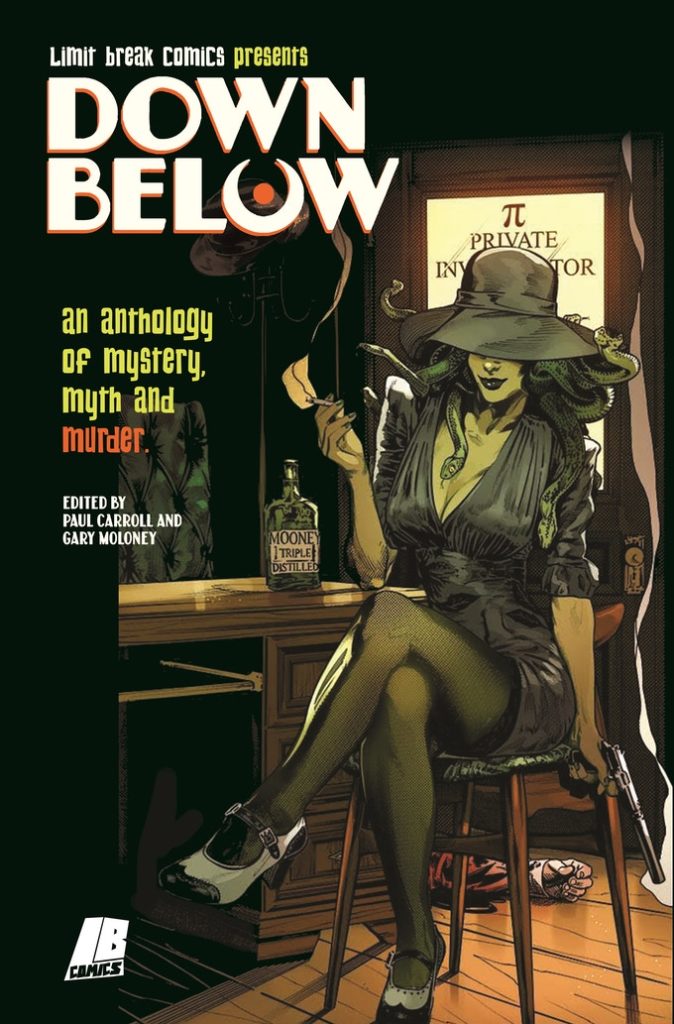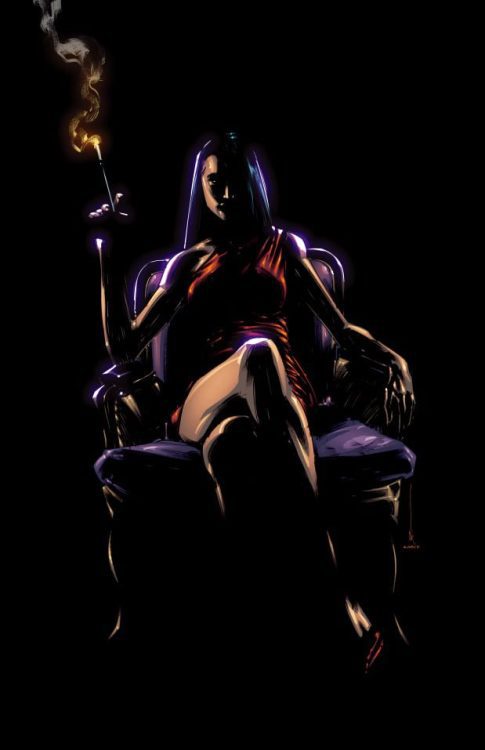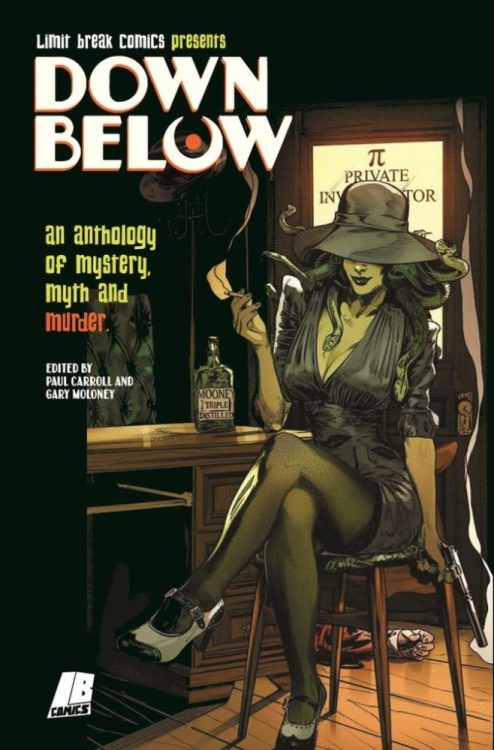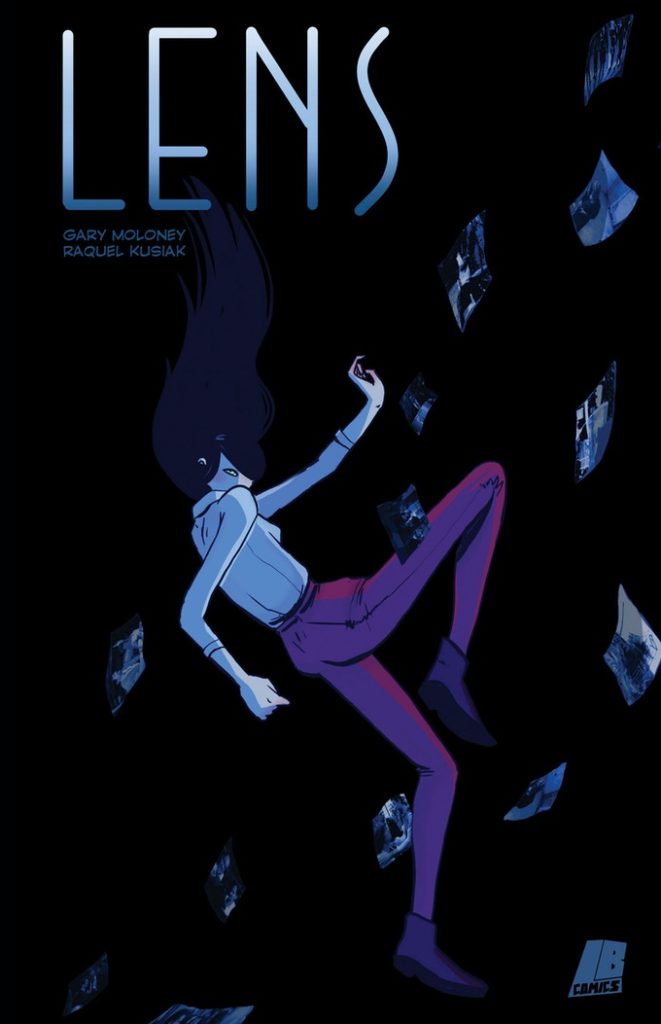DOWN BELOW is currently wrapping up its campaign on Kickstarter, and we talked with the anthology’s co-editor Gary Moloney about how the project came together, and the power of noir.
The book is a collection of stories inspired by Greek Mythology “with a noir twist.” Moloney is editing the anthology alongside Paul Carroll; the two are founding members, along with Gareth Luby, of the Dublin-based comic collective Limit Break (we’ve previously spoken with Carroll about TURNING ROADS, another anthology project published under the LB banner).
Check out the campaign for a full list of the creators involved, but know that DOWN BELOW boasts 22 creative teams to bring readers almost 90 pages worth of comics.
Read on for our full interview with Moloney:
Monkeys Fighting Robots: DOWN BELOW is the second anthology from Limit Break after TURNING ROADS; what did you guys learn from your first campaign that you brought into this one?
Gary Moloney: DON’T UNDERCHARGE FOR SHIPPING! In all seriousness though, I should clarify at the start that Paul Carroll was the sole editor on TURNING ROADS. I only contributed a story last time around. So, to a large extent, these are lessons I learned second-hand. We did speak at length, however, about what we wanted from this campaign specifically taking into account the experience of having done TURNING ROADS.
The success of TURNING ROADS took us all by surprise. We were always confident that we’d meet our goal, but we didn’t expect to more than double it. So while there had been some preliminary ideas for stretch goals, which mainly included prints from established Irish artists, the pressure was on to come up with ideas on the fly. They proved to be quite popular and that’s why this time around we built those into our initial funding goal, the result being we had our pin-up artists on-board before launching the project. It also meant that we could structure our stretch goals around providing increased page-rates to our existing 22 creative teams rather than using it to commission new artwork.
MFR: What about Greek mythology and noir made you guys think, “These things need to go together?”
Moloney: We’d been talking about what a follow-up to TURNING ROADS might look like for a while. We knew that we didn’t want to do a second volume on the same theme (or at least not straight away). Paul and I had been engrossed in the video game HADES for a good chunk of last year, which led us into a downward spiral of binging all of Rachel Smyth’s LORE OLYMPUS (which I’d highly recommend) and listening to HADESTOWN. The more we thought about it, the more we thought that Greek Mythology would make for an interesting canon to explore, though it was Paul who originally suggested the idea. The noir of it all really came from looking at the core themes of those stories. They’re filled with betrayal and tragedy. There is always a bittersweetness to Greek myths even when they ostensibly have a happy ending. What is noir but that same aftertaste?
So, thematically, it made sense to us and I thought it would really spur the creativity of those pitching to us given that crime comics are more popular than they’ve ever been. And, truth be told, I just really wanted to edit a crime anthology. I’d discovered my love for writing in the genre a few years ago when I was taking Declan Shalvey’s comics writing course and it had been something I’d been threatening to do for some time. DOWN BELOW gave me the opportunity to co-edit a book that would standout amongst the myriad of crime anthologies that are out there.

MFR: You and I have discussed our mutual love of noir at length; what is it about the genre that speaks to you personally?
Moloney: As you can imagine, I’ve been mulling this over quite a bit recently. I think many people hear the word “noir” and immediately think of a particular aesthetic. They jump to the pinstripe suit and fedora stereotype of Raymond Chandler novels (or at least what they think a Chandler character looks like). An aesthetic is not a genre though. Noir is so much more than that as modern comic creators have shown time and time again.
To me, when you really get to the heart of what noir is about, it’s the struggle against an unfair world. The protagonists of a noir story (for they are rarely heroes in the traditional sense) often find themselves coming up against societal structures far more powerful than themselves. Sometimes it’s the struggle against those systems and other times it’s the desire to become part of it. These structures, be they organised crime or something endemic like poverty or corruption within the police are things which no one person can dismantle. They require systemic change underpinned by collective action that is often not forthcoming. At most, all an individual can ever hope for is to make some small impact in the world around them. Noir is about those individuals. It’s about those who face the impossible odds. The noir detective or private eye can solve a particular case, but the underlying issues that brought it about remain at the end of the story. They’re under no illusions about the scope of their ability to affect change. They know they’ll lose more than they win. Their victories are short-lived, but they’ll take what they can get. So those fleeting moments are what noir authors tend to focus on even as they find themselves coming close and closer to a tragic end. That’s where the bittersweetness I spoke about previously comes into play. It’s also what distinguishes a noir story from other forms of crime fiction.
MFR: Care to tease some of the stories we’ll be seeing in DOWN BELOW?
Moloney: One of the things we really wanted to make sure is that we had a nice variety of stories that drew from different corners of the mythology. We didn’t want the same characters to be tripping over each other across stories. This made the process of narrowing down pitches very difficult as we had to choose between competing visions for certain myths. That being said we did have to make an exception when it came to Odysseus because the specific pitches in question each touched on him at such different points of his life that they’re effectively different characters. So those familiar with “The Odyssey” will be well-looked after.
Many of our stories are thematically inspired by Greek myth as opposed to engaging in a strict re-telling or adaptation. While you’ll see stories inspired by Sisyphus, the Minotaur, or Hades and Persephone, don’t come in expecting a simple re-skin of the classics. We weren’t really interested in going down that road, we gravitated towards stories that looked a little deeper and went beyond mere adaptations.
One of our contributors, Oliver Gerlach, is a classicist who works in this area, so he comes to the project not only with his comic background, but with the study of Greek mythology as his day job. I think because of that foundation people will get a kick out of his and artist Alex Moore’s take on Dionysus. If ever was there a team suited to tackling this material in comic form it’s them.
MFR: One of the add-on items for DOWN BELOW is your new comic LENS with Raquel Kusiak. Can you speak to that story and let readers know what it’s about?
Moloney: LENS is an espionage-thriller in the vein of Jack Reacher or Bridgette Sharpe which follows the adventures of Jane Danner, an award-winning photojournalist who also happens to moonlight as one of the world’s greatest assassins. The elevator comp pitch is essentially: “what if Lois Lane was secretly John Wick?” The original germ of the idea came from that same comic class I mentioned earlier. I had this image of a sniper concealing their gun in a camera bag, travelling the world to carry out political hits. The idea was to play with the notion that the 20th century had been shaped by the assassination of prominent public figures (such as MLK or JFK) as well as the advent of photojournalism which produced images that imprinted themselves on our shared cultural consciousness (the Tiananmen Square Massacre or Vietnam War). So, my question was, what if you had a hand in both?
Initially, I’d conceived of it as a standalone short story but a friend rightfully pointed out that the concept would be better suited to something longer in form. This led to my pitching the series to editor extraordinaire, Claire Napier, when she was began putting together a new comics anthology magazine: BUN & TEA, with the view to serialising a number of stories over the course of six-issues. Claire presented me with a number of potential artists to collaborate with and I was immediately struck by Raquel’s use of colour and her dynamic style. LENS wouldn’t be the book it is without her.
The magazine was designed to emulate UK-style anthologies such as 2000AD or SONIC THE COMIC, so each chapter or episode was to be five pages in length. While we were only supposed to put together a single pilot episode to begin with, the three of us ended up enjoying the process so much that we completed the whole six-episode story arc ourselves. The pandemic caused BUN & TEA to be delayed, but we eventually serialised LENS as a webcomic for free which can now be read collected as a one-shot in print form for those so inclined.
This first season sees Jane hired to take out a prominent tech-entrepreneur who for mysterious reasons has come to be viewed as an unacceptable liability by the US government. She quickly learns, however, that she’s not the only one on the job. What’s funny is that I wrote that entrepreneur character, Zack Zimmerman, very much as a satire of the kind of tech bros who would talk in nebulous terms about certain technologies which they claimed would revolutionise our everyday lives without ever explaining how or why that might be something we’d want in the first place. I was slightly worried in hindsight that this guy would come off as too much of a parody in the current climate. Of course, that didn’t account for everything that’s happened with the Blockchain these last few months and the almost cult-like nature of its proponents. If anything I think I didn’t go far enough!
In short, LENS is a neon-filled pulpy escapade that fans of JENNIFER BLOOD, FATALE, or THE COLDEST CITY are likely to enjoy. While this collection is a self-contained mission, we’ve built a story engine here that allows us to follow-up with further instalments in the future. We want this to be a series that has an underlying lore but is accessible to new readers no matter where you pick it up.
MFR: How have you changed and grown as a writer after making the jump to editor/publisher?
Moloney: I think that’s something I’m going to find out myself as I begin a few new writing projects over the coming months, we’re still in the process of making the book after all. Immediately, though, I know my mentality towards pitching short stories has changed. This process really cemented for me the need to design pitches in a way that immediately catches an editor’s attention. Writers need to learn to write for the pitch rather than the story.
We had 189 pitches — more than double what TURNING ROADS received — which was quite the undertaking. You simply don’t have the time to linger on pitches that aren’t clear or are otherwise difficult to navigate. With most anthologies, you can anticipate the kinds of pitches they are likely to receive. Those who submit Future Shocks to 2000AD are warned off “prisons of the mind” and “time travel” stories for this exact reason. So how do you stand out? Well, statistically speaking, you’re better off trying to look at under-explored themes or subjects rather than the more well-trodden paths. At the end of the day, most anthologies will only give you four pages. It’s not a lot. That’s a constraint but also an opportunity. You can afford to experiment with form and content. Even if it doesn’t work, you’ve learned a lot more by doing so and your next effort will be all the better for it.
MFR: Can you tease anything that’s coming up for Limit Break following DOWN BELOW?
Moloney: It’s important to understand that, outside of these mythology anthologies, Limit Break is more of a collective than a publisher. When we started we never had any intention of curating books like TURNING ROADS or DOWN BELOW. We were simply looking for a way to pool our creative resources and encourage each other to refine our craft. The scope of what we do has changed over time though as our network has expanded and people began to approach us with ideas. Most recently, fellow Irish writer Seamus Kavanagh asked if he could put out his short story collection, OLD GAME PLUS, through Limit Break. As fans of his previous work, we were only delighted to be able to help him through the process of putting that book together. There may be one or two more additions to the Limit Break roster before the year’s end, but I can’t say more than that.
In all honesty though, DOWN BELOW really is the focus at the moment. These anthologies are huge undertakings for us and take up a lot of creative headspace. At the same time each of us are still working away on our own books for self-publication or to be shopped around elsewhere. Paul and Gareth are getting started on the last issue of their funny-animal series, MEOUCH. Meanwhile, I’m currently working in the background on a fantasy-western with Daniel Romero and Becca Carey. Don’t be too surprised if you see another “myth-anthology” from us next year. All good things come to threes after all. As for the theme? Well, that would be telling…

MFR: And I’ve discovered some great comics just in chatting with you, so I’m always inclined to ask: what have you been reading lately?
Moloney: As a new parent, I haven’t had the chance to read as much or as widely as I’d like to of late. I do still manage to carve out time though to keep up with a few titles. I’ve been following the Massive-verse with great interest over the last year. I think those are a group of creators are doing something really unique with the independent superhero. Something we haven’t seen in many years. I’ve written a lot in the past about superhero comics being an intergenerational conversation between creators which each successive wave commenting or iterating on what came before. This is the first time you’re really starting to see the influence of Japanese imports such as anime and tokusatsu seep into the American superhero landscape. They’re taking that ball and running with it.
I’ve also really enjoyed TIME BEFORE TIME from Rory McConville, Declan Shalvey, Joe Palmer, and Hassan Ostmane-Elhaou. That’s an example of taking a well-trodden concept like time travel and doing something new, by removing the risk of paradox and focusing on the personal drama.
On the Irish side of things, I’ve just finished BLAZE BEYOND THE PALE, a new graphic novel by Aaron Losty and Becca Carey (with colour assistance by JP Jordan). It’s an incredible work about growing up in inner city Dublin and the very particular experiences that come from that. Few comics ever truly capture the feel and character of a place, but there Fingal is perfectly realised. If you want to get a real sense of what urban life and culture is like in certain parts of Ireland, I can’t recommend BLAZE BEYOND THE PALE enough. I’m really glad that the team on that book also have a story in DOWN BELOW which will be an absolute visual treat for all involved.
I’ve also found myself following along with daily webcomics published on Irish Comics Dot IE. Every day features a new instalment from a different series by Irish or Ireland-based comics creators. There’s something for whatever mood you’re in whether its comedy, action, or romance.
Thanks again to Gary Moloney for taking the time to talk with us. You can back DOWN BELOW right here on Kickstarter.



